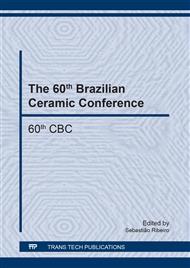p.1
p.7
p.12
p.16
p.21
p.27
p.33
p.39
p.44
Influence of Addition of CaO and SiO2 in Microstructure of Hexaferrite BaXSr1-XFe12O19
Abstract:
This study is aimed to verify the influence of adding SiO2 and CaO in the sintering temperature of hexaferrite, obtained by standard ceramic methods. The powders were weighed in stoichiometric amounts, milled for 1 hour under a high energy mill and calcined at 1000 °C/24h. To study the effect of concentration of additives on the microstructure of the hexaferrite samples were prepared without additives, and with simultaneous addition of SiO2 and CaO, wherein the total concentration of the additive was 1%. The morphology and particle size of the samples were determined by SEM and the crystal structure was determined by XRD and the phases were quantified by the Rietveld method. The XRD data showed the predominance of magnetoplumblico structure with hexagonal symmetry and space group P63/mmc. All samples have distributed grain heterogeneously, clustered in different masses, with acute forms and some of them featuring hexagonal shapes with different sizes.
Info:
Periodical:
Pages:
21-26
Citation:
Online since:
January 2018
Price:
Сopyright:
© 2018 Trans Tech Publications Ltd. All Rights Reserved
Share:
Citation:


